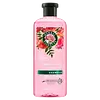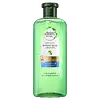What's inside
What's inside
 Key Ingredients
Key Ingredients

 Benefits
Benefits

 Concerns
Concerns

 Ingredients Side-by-side
Ingredients Side-by-side

Water
Skin ConditioningSodium Laureth Sulfate
CleansingSodium Lauryl Sulfate
CleansingCocamidopropyl Betaine
CleansingCitric Acid
BufferingSimmondsia Chinensis Seed Oil
EmollientRosa Canina Fruit Extract
AstringentSodium Citrate
BufferingSodium Xylenesulfonate
Parfum
MaskingCocamide Mea
EmulsifyingSodium Chloride
MaskingSodium Benzoate
MaskingTetrasodium EDTA
PEG-60 Almond Glycerides
EmulsifyingLinoleamidopropyl Pg-Dimonium Chloride Phosphate
Guar Hydroxypropyltrimonium Chloride
Skin ConditioningMethylchloroisothiazolinone
PreservativeMethylisothiazolinone
PreservativeCI 17200
Cosmetic ColorantCI 19140
Cosmetic ColorantBlue 1 Lake
Cosmetic ColorantWater, Sodium Laureth Sulfate, Sodium Lauryl Sulfate, Cocamidopropyl Betaine, Citric Acid, Simmondsia Chinensis Seed Oil, Rosa Canina Fruit Extract, Sodium Citrate, Sodium Xylenesulfonate, Parfum, Cocamide Mea, Sodium Chloride, Sodium Benzoate, Tetrasodium EDTA, PEG-60 Almond Glycerides, Linoleamidopropyl Pg-Dimonium Chloride Phosphate, Guar Hydroxypropyltrimonium Chloride, Methylchloroisothiazolinone, Methylisothiazolinone, CI 17200, CI 19140, Blue 1 Lake
Water
Skin ConditioningLauramidopropyl Betaine
CleansingSodium Cocoyl Isethionate
CleansingSodium Citrate
BufferingSodium Lauroyl Sarcosinate
CleansingCitric Acid
BufferingParfum
MaskingSodium Benzoate
MaskingSodium Salicylate
PreservativePolyquaternium-10
Benzyl Salicylate
PerfumingTetrasodium EDTA
Hexyl Cinnamal
PerfumingLimonene
PerfumingPropylene Glycol
HumectantGeraniol
PerfumingAloe Barbadensis Leaf Juice
Skin ConditioningButylene Glycol
HumectantHistidine
HumectantBambusa Vulgaris Shoot Extract
AntioxidantAlcohol Denat.
AntimicrobialLactic Acid
BufferingVitis Vinifera Seed Extract
AntimicrobialPotassium Sorbate
PreservativeEcklonia Radiata Extract
Skin ConditioningWater, Lauramidopropyl Betaine, Sodium Cocoyl Isethionate, Sodium Citrate, Sodium Lauroyl Sarcosinate, Citric Acid, Parfum, Sodium Benzoate, Sodium Salicylate, Polyquaternium-10, Benzyl Salicylate, Tetrasodium EDTA, Hexyl Cinnamal, Limonene, Propylene Glycol, Geraniol, Aloe Barbadensis Leaf Juice, Butylene Glycol, Histidine, Bambusa Vulgaris Shoot Extract, Alcohol Denat., Lactic Acid, Vitis Vinifera Seed Extract, Potassium Sorbate, Ecklonia Radiata Extract
Ingredients Explained
These ingredients are found in both products.
Ingredients higher up in an ingredient list are typically present in a larger amount.
Citric Acid is an alpha hydroxy acid (AHA) naturally found in citrus fruits like oranges, lemons, and limes.
Like other AHAs, citric acid can exfoliate skin by breaking down the bonds that hold dead skin cells together. This helps reveal smoother and brighter skin underneath.
However, this exfoliating effect only happens at high concentrations (20%) which can be hard to find in cosmetic products.
Due to this, citric acid is usually included in small amounts as a pH adjuster. This helps keep products slightly more acidic and compatible with skin's natural pH.
In skincare formulas, citric acid can:
While it can provide some skin benefits, research shows lactic acid and glycolic acid are generally more effective and less irritating exfoliants.
Most citric acid used in skincare today is made by fermenting sugars (usually from molasses). This synthetic version is identical to the natural citrus form but easier to stabilize and use in formulations.
Read more about some other popular AHA's here:
Learn more about Citric AcidParfum is a catch-all term for an ingredient or more that is used to give a scent to products.
Also called "fragrance", this ingredient can be a blend of hundreds of chemicals or plant oils. This means every product with "fragrance" or "parfum" in the ingredients list is a different mixture.
For instance, Habanolide is a proprietary trade name for a specific aroma chemical. When used as a fragrance ingredient in cosmetics, most aroma chemicals fall under the broad labeling category of “FRAGRANCE” or “PARFUM” according to EU and US regulations.
The term 'parfum' or 'fragrance' is not regulated in many countries. In many cases, it is up to the brand to define this term.
For instance, many brands choose to label themselves as "fragrance-free" because they are not using synthetic fragrances. However, their products may still contain ingredients such as essential oils that are considered a fragrance by INCI standards.
One example is Calendula flower extract. Calendula is an essential oil that still imparts a scent or 'fragrance'.
Depending on the blend, the ingredients in the mixture can cause allergies and sensitivities on the skin. Some ingredients that are known EU allergens include linalool and citronellol.
Parfum can also be used to mask or cover an unpleasant scent.
The bottom line is: not all fragrances/parfum/ingredients are created equally. If you are worried about fragrances, we recommend taking a closer look at an ingredient. And of course, we always recommend speaking with a professional.
Learn more about ParfumSodium Benzoate is a preservative. It's used in both cosmetic and food products to inhibit the growth of mold and bacteria. It is typically produced synthetically.
Both the US FDA and EU Health Committee have approved the use of sodium benzoate. In the US, levels of 0.1% (of the total product) are allowed.
Sodium benzoate works as a preservative by inhibiting the growth of bacteria inside of cells. It prevents the cell from fermenting a type of sugar using an enzyme called phosphofructokinase.
It is the salt of benzoic acid. Foods containing sodium benzoate include soda, salad dressings, condiments, fruit juices, wines, and snack foods.
Studies for using ascorbic acid and sodium benzoate in cosmetics are lacking, especially in skincare routines with multiple steps.
We always recommend speaking with a professional, such as a dermatologist, if you have any concerns.
Learn more about Sodium BenzoateSodium Citrate is the sodium salts of citric acid. In skincare, it is used to alter pH levels and acts as a preservative.
Its main functions are to maintain the pH of a product and neutralize metal ions.
The acidity of our skin is maintained by our glands and skin biome; normal pH level of skin is slightly acidic (~4.75-5.5).
Being slightly acidic allows our skin to create an "acid mantle". This acid mantle is a thin barrier that protects our skin from bacteria and contaminants.
Learn more about Sodium CitrateTetrasodium EDTA is the salt formed from neutralizing ethylenediamine tetraacetic acid with sodium hydroxide. It is a chelating agent and used to prevent metal ions from binding to other ingredients. This helps keep the product and ingredients stable.
Tetrasodium EDTA comes as a white solid and is soluble in water.
Water. It's the most common cosmetic ingredient of all. You'll usually see it at the top of ingredient lists, meaning that it makes up the largest part of the product.
So why is it so popular? Water most often acts as a solvent - this means that it helps dissolve other ingredients into the formulation.
You'll also recognize water as that liquid we all need to stay alive. If you see this, drink a glass of water. Stay hydrated!
Learn more about Water